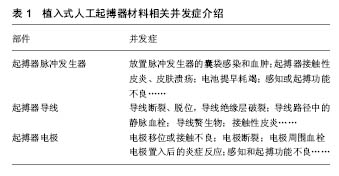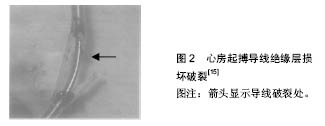| [1]Herrlich S, Spieth S, Gerstmann H,et al.Drug release mechanisms of steroid eluting rings in cardiac pacemaker lead electrodes.Conf Proc IEEE Eng Med Biol Soc. 2012; 2012:681-684.[2]赖卫国.被动起搏电极参数随访分析[D].北京:中国协和医科大学:2008.[3]Singarayar S, Kistler PM, De Winter C,et al.A comparative study of the action of dexamethasone sodium phosphate and dexamethasone acetate in steroid-eluting pacemaker leads.Pacing Clin Electrophysiol. 2005;28(4):311-315.[4]Gradaus R, Böcker D, Dorszewski A,et al.Fractally coated defibrillation electrodes: is an improvement in defibrillation threshold possible?Europace. 2000;2(2):154-159.[5]Lubiński A, Lewicka-Nowak E, Zienciuk A, et al.Comparison of defibrillation efficacy using implantable cardioverter- defibrillator with single- or dual-coil defibrillation leads and active can.Kardiol Pol. 2005; 63(3):234-241[6]刘志刚,高东升,袁方,等.铱分型镀覆和激素释放电极导线起搏参数的动态变化[J].中国心脏起搏与心电生理杂志, 2005,19(2):92-95. [7]Grossenbacher J, Gullo MR, Dalcanale F,et al.Cytotoxicity evaluation of polymer-derived ceramics for pacemaker electrode applications.J Biomed Mater Res A. 2015;103(11): 3625-3632.[8]Chou HA, Frenkel D, Ovadia M.Determination of standard electrode potential E(o) for chronic platinum and gold electrodes in rat muscle: implications for biosensors and the "anode" of bipolar pacing.Pacing Clin Electrophysiol. 2002; 25(7):1053-1060. [9]许少波.起搏器用植入材料的细胞毒性研究[J].中国医疗器械信息,2011,17(2):13-15. [10]Berger T, Roithinger FX, Antretter H, et al.The influence of high versus normal impedance ventricular leads on pacemaker generator longevity.Pacing Clin Electrophysiol. 2003; 26(11):2116-2120.[11]Auricchio A, Delnoy PP, Regoli F, et al.First-in-man implantation of leadless ultrasound-based cardiac stimulation pacing system: novel endocardial left ventricular resynchronization therapy in heart failure patients.Europace. 2013;15(8):1191-1197.[12]黄德群.有源植入式医疗器械外壳封装工艺分析[J].2009, 24(8): 73-75.[13]Tamenishi A, Usui A, Oshima H,et al.Entirely polytetrafluoroethylene coating for pacemaker system contact dermatitis.Interact Cardiovasc Thorac Surg. 2008;7(2):275-277.[14]Hamada M, Kayashima M, Uryu M,et al.Pressure cutaneous ulcer over a pacemaker successfully treated with left subcostal transplantation in an extremely thin patient.J Dermatol. 2006;33(8):567-570.[15]黄抒伟,沈法荣,凌锋,等.导线绝缘层破裂致起搏器电池提前耗竭一例[J].中华心律失常学杂志,2015,9(6):462.[16]王波,王显. 临时起搏器并发电极导线周围血栓1例[J].中国循证心血管医学杂志,2014,(5):631-631.[17]李慎义,陈莉.心脏起搏器置入术后并发导线血栓形成及三尖瓣、右室流出道重度狭窄1例[J].中国临床医学影像杂志,2011,22(11):828.[18]Taguchi T, Maeba S, Sueda T.Prevention of pacemaker- associated contact dermatitis by polytetrafluoroethylene sheet and conduit coating of the pacemaker system.J Artif Organs. 2014;17(3):285-287.[19]Vodiskar J, Schnöring H, Sachweh JS,et al. Polytetrafluoroethylene-coated pacemaker leads as surgical management of contact allergy to silicone. Ann Thorac Surg. 2014;97(1):328-329.[20]陈国方,江隆福,蔡小婕.心脏起搏器起搏电极脱位7例分析[J].心脑血管病防治,2014,14(3):259-260.[21]耿学军.电极断裂致VVI起搏器起搏及感知障碍1例[J].心电与循环,2012,31(2):107.[22]陈静.起搏器心房电极脱位伴心室电极断裂1例[J].实用医学杂志, 2008,24(8):1326.[23]李正恭,张源,申林,等. 心脏起搏器电极血栓3例报道[J].重庆医学,2006,35(9):封3-封4.[24]史扬, 耿仁义.起搏器囊袋感染相关危险因素分析[J].中华医院感染学杂志,2010,20(6):797-798.[25]周莲, 文玲, 朱建芳.8例永久性人工心脏起搏器植入术后囊袋破溃感染分析[J].局解手术学杂志,2010,19(6):533. |
.jpg)


.jpg)
.jpg)